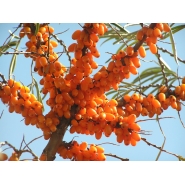1. What is Sea buckthorn?
Sea buckthorn (Hippophae rhamnoides L.) is a hardy, deciduous shrub belonging to the family Elaeagnaceae. It bears yellow or orange fruits that have been used for centuries in both Europe and Asia for food, therapeutic and pharmaceutical purpose.
In ancient Greece, leaves and yound branches were added to horse fodder which resulted in weight gain and healthy shine to the horse’s coat. The generic Latin name, Hippophae, derives from this practice as it means shining horse.
2. What is the origin of Sea buckthorn?
Documented in 1200 year ago earliest included Chinese Tibetan medicine classics – “Four Medical Classics”. This book includes records and information of sea-buckthorn in medical applications. The plant’s orange fruit with the oil from its pulp and seeds have been used traditionally for skin conditions, coughing, phlegm reduction, and digestive disorders.
A sea buckthorn industry has been thriving in Russia since the 1940’s when scientists there began investigating the biologically active substances found in fruit, leaves and bark.
3. Where can we find it ?
Sea buckthorn occurs as a native plant distributed widely throughout China, Mongolia, Russia and United kingdom, France, Denmark, Netherlands, Germany, Poland, Finland, Sweden and Norway.
4. What are the clinical implication of each part of Sea buckthorn ?
Sea buckthorn’s fruit, seeds contain large amounts of essential oil and vitamin C. In general, its fruits are very high in health promoting compounds. For example, sea buckthorn is high in protein, especially globulins and albumins, carotene, fatty acids and vitamin E. Fatty acid and vitamin E contents are higher than wheat, safflower, maize and soybean.
Sea buckthorn may strengthen non-specific immunity functions, as demonstrated by anti-anaphylactic effects and increased phagocytic activity, and the juice is reported to improve the multiplication index of splenic lymphocytes in mice. Sea buckthorn juice contains superoxide dismutase, which provides anti-oxidant activity, clearing free radicals from membrane systems.
Seed oil has anti-inflammatory, antimicrobial, and analgesic effects. It is also beneficial in promotion of regeneration of tissues, elimination of free radicals and reduction of oxidation of unsaturated fat in the fatty membrane. Seed oil is commonly used for wound-healing, cosmetology and skin grafting.






























